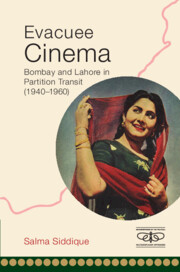Book contents
- Frontmatter
- Dedication
- Contents
- List of Figures
- Acknowledgements
- Introduction: A Moving Picture
- 1 The All-India Ambitions of Lahore
- Part 1 The Secular Stance of Bombay
- Part 2 Between Bombay and Pakistan
- Conclusion: Evacuee Cinema
- Appendix: Three Film Transcripts from the Fazli Family Collection
- Filmography
- Bibliography
- Index
6 - The Partition Doppelgänger: Rattan Kumar and the Pakistani Charbas
Published online by Cambridge University Press: 11 October 2022
- Frontmatter
- Dedication
- Contents
- List of Figures
- Acknowledgements
- Introduction: A Moving Picture
- 1 The All-India Ambitions of Lahore
- Part 1 The Secular Stance of Bombay
- Part 2 Between Bombay and Pakistan
- Conclusion: Evacuee Cinema
- Appendix: Three Film Transcripts from the Fazli Family Collection
- Filmography
- Bibliography
- Index
Summary
Let us drink.
To Pakistan, where you went,
To India, where you will return,
To the Siamese Twins.
In cultural representation of partition, the divided nations of India and Pakistan are often anthropomorphised and likened to twins or two brothers. The desperate celebration of two inebriated friends in Attia Hosain's incomplete novel has its parallel of two feuding brothers in the Prithvi Theatre's play Deewar (Wall). The difference(s) and breakage of unity are recast in these as duality and replication. A common allegorical device in narrativising partition, the power of ‘the double’ also constitutes Lahore's industrial response to the territorial division and dislocation through charbas, or film remakes. I approach this category of film through the star biography of Rattan Kumar. Rattan, whose real name was Syed Nazir Ali, was a child star who started his film career in independent India in the late 1940s. After achieving popularity and recognition for his roles in Hindi films, Rattan migrated to Pakistan in 1956. Riding on this fame, his family started a film production company and produced several films featuring the adolescent. Like most child stars of Hollywood as well as popular Hindi cinema, Rattan's adult career was not a success. However, in his case the age divide between success and failure was also one highly charged with a split in national affiliation.
Rattan's migration has an ideological potency, evident in its marginality in Indian and centrality in Pakistani accounts. This potency is what Jane O’Connor refers to as the cultural significance of the child star as a ‘complex figure with inherent powers to generate emotions and embody hope’. A letter in a Pakistani film magazine published in 1963 – seven years after Rattan moved to Pakistan – diagnosed the actor's plummet in popularity after his move.
Rattan had done well in Jagriti in India. No credit goes to him in Bedari. I know when he was a boy of 8 or 10 his acting was excellent and marvellous; I liked his childhood acting very much. I thought that when Rattan would be a young man of 25, he will become the best hero of Indo-Pak subcontinent and will even replace Dilip.
- Type
- Chapter
- Information
- Evacuee CinemaBombay and Lahore in Partition Transit, 1940–1960, pp. 176 - 219Publisher: Cambridge University PressPrint publication year: 2023

